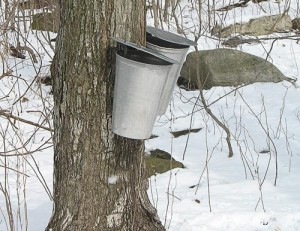 Americans tend to like sweet stuff and most of us eat more of it than we should.
Americans tend to like sweet stuff and most of us eat more of it than we should.
Although we’re warned to be conscious of the amount of sugar we eat, that doesn’t mean never eat anything sweet. Of course, some people choose not to, but if you do – eat the good stuff – like real maple syrup.
Who Made Maple Syrup First?
Maple trees are tapped in early Spring for the sap used to make syrup. The sap is a clear, watery liquid which is boiled down to concentrate it into syrup.
Native Indians in the US and Canada were probably the first producers of maple products. They would make gashes in the trees, collect the sap, let it partially freeze to enrich it, then reduce it by heating, sometimes by dropping heated stones into the collected sap.
Ideal Conditions
This year’s harsh winter created great conditions for an incredible maple syrup season. The below freezing nights and above freezing days were ideal and nearly doubled production at some sugar shacks, especially for light grades of syrup.
The syrup color generally depends on the time of the season the sap is collected. Lighter syrup tastes cleaner and more sugary and usually results from colder temperatures earlier in the season. Dark syrup has a different sugar content, a taste that lingers in your mouth, and usually comes from sap collected later in the season.
Some Maple Sugaring Facts
According to the Stamford Museum and Nature Center (CT):
- About 40 gallons maple sap are needed to make 1 gallon of maple syrup
- Fresh sap is 2% sugar; maple syrup is 67% sugar
- A tree must be at least 10 inches in diameter before it can be tapped; each taphole averages 10 gallons of sap a season
- A sugar maple takes about 40 years to reach 10″ in diameter and there is no permanent damage if only 10% of its sap is collected annually
- In the US, Vermont is the largest syrup producer, Maine is second, New York is third
- In 2006 the US produced 1,449,000 gallons of maple syrup — Canada produced over 7 million
- Maple syrup has 40 calories a tablespoon; corn syrup has 60
What’s The Difference Between Real Maple Syrup And Commercial Pancake Syrups?
The sticky stuff, often called pancake syrup, that you likely find in your local diner and in the Aunt Jemima and Mrs. Butterworth’s bottles on your supermarket shelves is not considered “real” maple syrup. That’s because it’s not made from maple sap but rather from a mixture of corn syrup, high fructose corn syrup, and a chemical soup of colorings, flavors, and preservatives.
Real maple syrup is graded. In the US (Canada has different grading) the grading is:
- Grade A Light Amber: light amber color, light and mild maple flavor
- Grade A Medium Amber: medium amber color, a bit more maple flavor, the most popular grade for table use
- Grade A Dark Amber: dark amber color, strong maple flavor
- Grade B: dark color, usually used for cooking and baking

Leave a Reply